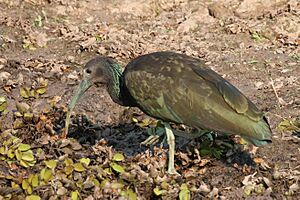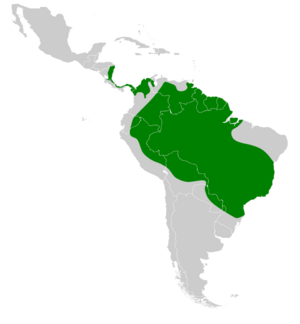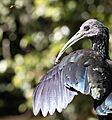Green ibis facts for kids
Quick facts for kids Green ibis |
|
|---|---|
 |
|
| in the Pantanal, Brazil | |
| Conservation status | |
| Scientific classification | |
| Genus: |
Mesembrinibis
|
| Species: |
cayennensis
|
 |
|
The green ibis (Mesembrinibis cayennensis), also known as the Cayenne ibis, is a type of wading bird. It belongs to the ibis family, called Threskiornithidae. This bird is special because it's the only member of its group, the genus Mesembrinibis.
You can find the green ibis living in many places. It breeds from Honduras through Nicaragua, Costa Rica, and western Panama. It also lives across South America all the way to northern Argentina. Sometimes, these birds move to different areas during the dry season.
Contents
About the Green Ibis
The green ibis got its scientific name, Tantalus cayennensis, in 1789. This name was given by a German scientist named Johann Friedrich Gmelin. Later, in 1930, James Lee Peters created the genus Mesembrinibis, and the green ibis is the only species in it.
The name Mesembrinibis comes from Greek words. Mesēmbrinos means "southern," and "ibis" is the bird's name. The second part of its scientific name, cayennensis, means "from Cayenne" or "French Guiana." This bird is also sometimes called the Cayenne ibis.
What Does It Look Like?
The green ibis is a medium-sized bird. It measures about 45 to 60 centimeters (18 to 24 inches) long. It usually weighs between 700 and 890 grams (1.5 to 2 pounds).
It has short legs and a long, thin bill that curves downwards. Both male and female green ibises look alike. Adult birds have shiny greenish-black bodies. Their legs and bill are pale green, and they have grey skin patches on their face.
Young green ibises are not as bright in color. When they fly, green ibises stretch their necks out, just like other ibises. Their flight looks heavy, with strong wingbeats.
Its Call
The green ibis makes a hollow, hooting sound. It speeds up as it calls. You'll most often hear this sound at dawn and dusk. People describe its call as a "mellow" kro kro or koro koro.
Similar Birds
If you see a green ibis in good light, it's easy to tell apart from other birds. It looks very dark. However, in dim light, you might confuse it with the glossy ibis. The glossy ibis is more of a bronzy-maroon color. It also has longer legs and a thinner body than the green ibis.
Where It Lives
The green ibis lives in many parts of Central and South America. You can find it from Costa Rica south to northern Argentina and Paraguay. It likes different kinds of wet, forested places. This includes swamps and the edges of rivers and lakes. They usually live at altitudes up to 500 meters (1,600 feet).
How It Behaves
The green ibis is mostly active at dawn and dusk. It's not as social as other ibises. You'll usually see it alone or in pairs. If it does join a group of different bird species, it tends to stay on the edges. It often perches in trees.
What It Eats
Like other ibises, the green ibis eats fish, frogs, and other small water creatures. It also enjoys eating insects.
Reproduction
The green ibis builds a simple nest out of twigs. It places its nest high up in a tree.
Protecting the Green Ibis
The green ibis is considered a species of least concern by the International Union for Conservation of Nature. This is because it lives in a very large area and has a big population. However, the number of green ibises seems to be going down. People in Central and South American countries sometimes hunt and eat them.
The crested caracara is a known predator of the green ibis. There have been sightings of caracaras chasing and attacking green ibises in the air. They would force the ibis to the ground and kill it by pecking its head.
Images for kids
-
Green ibis perched on a log in Tortuguero National Park.



